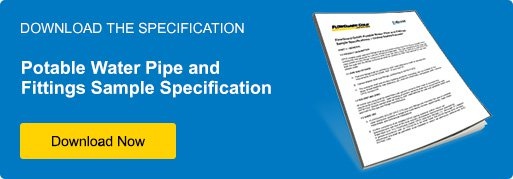
By: Brian Courtright on November 30th, 2020
CONSIDERATIONS WHEN VALUE ENGINEERING YOUR PIPING SYSTEM
When value engineering a plumbing system, a product’s cost is just one of many factors that must be considered. Proper value engineering is a methodical effort that analyzes a system’s design, features, equipment, material selections and many other important variables with the goal of maintaining or enhancing the performance of a system for the lowest overall cost while maintaining code compliance. Unfortunately, while cost and code compliance is often considered in the value engineering process, the impact of material changes on system performance is rarely considered.
Two Ways to Increase a Piping System’s Value
Determining a system’s value is ultimately an evaluation of both cost and function. To boost the value of a piping system, you can increase its function, decrease its cost, or preferably both. Fortunately, your choice of the piping material alone can greatly impact both halves of this equation given the range of prices and performance attributes available in today’s market.
Different Materials Perform Differently
When you receive a value engineering submittal, it is important to consider how the material change can impact the performance of the overall system. Because of the differences between copper, PEX and FlowGuard Gold® CPVC, failure to account for these key differences could result in:
- Failure to comply with code requirements
- Under-performance of the system
- Pre-mature system failure
- Extra, unbudgeted costs
Simply understanding these material differences is not enough. They must be incorporated into the system design to have an impact – a step often skipped in “plug-and-play" value engineering substitutions.
Maintaining Code Compliance
Typically, one of the first things an engineer will consider when reviewing a submittal is whether or not the product complies with the applicable codes. In most cases, this process is fairly straightforward. However, when it comes to plenum ratings, certain limits apply to PEX systems that are not seen with FlowGuard Gold CPVC.
While these limitations vary by manufacturer, most PEX systems require each small diameter pipe be spaced a minimum 18” apart in order to fulfill their plenum ratings. Otherwise, the pipe must be fully encased in a plenum rated wrap. While the pipe itself may be listed and labeled to ASTM E84, without specific engineering guidance, the product may not be installed in compliance with its listing.
FlowGuard Gold CPVC is plenum rated without any spacing or insulation requirements, allowing it to be installed in the same manner that a copper system would be installed.
Optimizing System Performance
When it comes to plumbing system performance, one of the most important factors to consider is the ability to deliver adequate water volume and pressure. When systems are designed for copper or CPVC materials, assumptions are made based on calculations for pressure drop that can influence key cost drivers like pipe diameter.
When value engineering from copper or CPVC to PEX, the design must be modified to account for the increased pressure drop caused by PEX insert fittings. Because PEX insert fittings introduce between 7-10x more pressure drop than the comparable FlowGuard Gold fitting, the PEX system may need to be upsized or incorporate more exotic designs to ensure adequate water volume and pressure.
In addition, some codes and PEX manufacturers recommend a velocity limit of 2 ft./sec. for hot water recirculating systems. In most cases, the only way to ensure adequate water volume at those velocities is to upsize the system. By comparison, copper systems may be limited to 5-8 ft./sec. and FlowGuard Gold CPVC is limited to 8-10ft./sec., meaning that the same volume of water can be delivered at much smaller diameters.
These remediation efforts can increase costs and negate any cost benefit proposed by the contractor. What’s more likely, however, is that without an updated design standard, the contractor will not attempt any remediation, ultimately resulting in inadequate pressure and/or system under-performance.
Avoiding System Failures
One reason velocities are limited in hot-water recirculating PEX systems is due to concerns over a fundamental incompatibility between PEX piping and chlorinated water. While PEX piping is evaluated to ASTM F2023 for chlorine resistance, that standard has several key limits that must be factored into the design. These limits are explored in Plastics Pipe Institute Technical Note 53 and include:
- Temperatures over 140F
- Pressures over 80psi
- Water with an oxidative reduction potential over 825mV
When allowing PEX piping to be used in a building, either in the initial spec or on a value engineering submittal, these factors should be incorporated into the design. Other limiting factors for PEX in chlorinated water include the design velocity and potential UV exposure prior to, during or after installation. Failure to account for these limitations can invalidate PEX warranties, leading to major headaches when problems arise.
Another key element to consider that may result in system failures is the role of chemical compatibility. While all materials are susceptible to failures caused by incompatible chemicals, these vulnerabilities vary from material to material. FlowGuard Gold CPVC is backed by the FBC System Compatible Program which helps engineers and contractors select and specify compatible building products. Unfortunately, with PEX systems, there is no such program for evaluating chemical compatibility, leaving engineers and contractors to either guess or independently verify each product with the manufacturer.
Beware of Hidden Costs
With pressure and velocity limits, the proper remediation is to upsize the system, which can add significant cost if properly implemented.
Conversely, if a system was designed with PEX insert fittings in mind, value engineering to FlowGuard Gold CPVC can significantly reduce the pressure drop and may allow for downsizing the piping system, resulting in additional cost savings beyond the basic material costs.
When it comes to matters of code compliance and system failures, the costs are more obvious, but aren’t factored into a typical value engineering analysis. To avoid these issues down the road, these factors must be considered up front during the specification and submittal process.
These hidden costs of using PEX may not show up in the initial bid but can arise later as costly change orders that offset the benefits initially presented in the submittal.
Tap Into Expert Engineering Resources
As the pioneers in CPVC piping, the FlowGuard Gold CPVC team can help you. With industry-leading resources for planning and purchasing, hands-on training and ongoing support, we can help ensure you control the costs on your projects while maintaining or improving performance.
Compare the sample specifications for FlowGuard Gold CPVC and PEX plumbing systems to determine which material is the best solution for the job.


